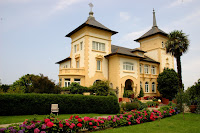The explosions occurred during the morning rush hour, targeting a busy commuter rail line into Atocha station from Alcalá. At 7.37 four bombs, planted in different carriages of a single train, exploded inside Atocha station. Two minutes later three bombs exploded on a train held at calle de Téllez by a red signal just 500 metres out of Atocha. The presumption is that the bombs were planned to go off inside Atocha, Madrid's busiest railway station. Meanwhile, at El Pozo station, two more bombs detonated at 7:38 on another train. A single bomb, also at 7.38, killed more at Santa Eugenia station. Four trains and ten bombs. Bomb disposal teams found and detonated two more bombs in controlled explosions on the train at calle de Téllez. Another unexploded device, which was apparently of a different design to all the others, had been on the El Pozo train. It was later discovered, inside Vallecas police station, where it had been taken with other items. One reason given for that bomb not going off was that the timer had been set twelve hours late in a confusion between am and pm.
11-M, the Madrid Atocha bombings, are the worst terrorist attack in modern Spanish history. They wrested that unhappy record from the 1987 attack by ETA on a Hipercor store in Barcelona with 21 dead and 40 injured. In fact the attacks were the deadliest in Europe since the 1988 Lockerbie bombing. More people died in the Atocha train bombings than died in Paris in November 2015.
The bombings had an important political effect. Spain was just three days away from a General Election when the bombs went off. Opinion polls at the time were predicting a victory for the ruling Partido Popular led by José María Aznar. Government sources pointed the finger at the Basque terror group, ETA, though they quickly denied any involvement. The suggestion is that Aznar thought that the public would perceive an ETA attack as the death throes of a terrorist organisation throttled by a firm Government. An Islamist attack on the other hand would be seen as the result of him deploying Spanish troops in Iraq. One was good politics, the other bad. That's probably why when, for instance, the police found a stolen van containing detonators and Arabic language materials near Alcalá station and later, as the evidence of an Islamist attack mounted, the PP stubbornly maintained the ETA hypothesis.
Aznar lost the elections. José Luis Zapatero, the victor, fulfilled his promise to withdraw Spanish troops from Iraq. Nowadays, the view is that the surprise victory had more to do with the public reaction to what was seen as the Government disinformation rather than a direct Iraqi war link.
During the investigation seven men including two suspected ringleaders of the bombings blew themselves up as police closed in on them. The blast killed a policeman. Twenty eight people eventually went to trial in what the original trial judge described as a mixed bag of Islamic extremists. Twenty one of them were convicted but seven were acquitted including one of the alleged masterminds. Four of the sentences were later overturned
-------------------------------------------
Just a word of warning. In writing this article I came across multiple factual contradictions and differences in what should have been simple information. I tried to steer through but I cannot be certain that there are no errors in the account.










